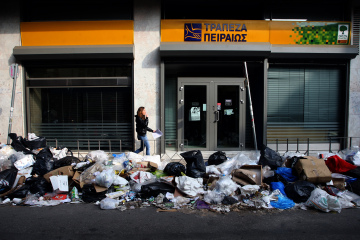Greece's Garbage Crisis: A Stinky Metaphor for an Economy in the Dumps
 It is like a dark inversion of the tourist images of Greece. Seagulls circle not over the clear blue waters of the Aegean, but a bleak, cratered landscape, swooping down to compete with human scavengers and mangy dogs for spoils in a sea of waste. The landfill in the municipality of Fyli receives the lion’s share of the 6,000 tons of garbage produced every day in Attica, the region that is home to the Greek capital Athens and 35% of the country’s entire population.
It is like a dark inversion of the tourist images of Greece. Seagulls circle not over the clear blue waters of the Aegean, but a bleak, cratered landscape, swooping down to compete with human scavengers and mangy dogs for spoils in a sea of waste. The landfill in the municipality of Fyli receives the lion’s share of the 6,000 tons of garbage produced every day in Attica, the region that is home to the Greek capital Athens and 35% of the country’s entire population.Greece’s surfeit of garbage has become one of the most visible — and pungent — symptoms of its debt crisis. A report commissioned by the European Commission last year ranked the country as the European Union’s least efficient in its implementation of European waste-management directives. It still buries 80% of its waste, while the E.U. average is 38% and some member states have deployed recycling and recovery to reduce the amount that ends up in the ground to less than 1%. Moreover, Greece’s landscape is still littered with hundreds of illegal dump sites. This doesn’t just threaten public health and the environment, but also the recovery prospects for its long-suffering public finances. The European Commission said in February that it is taking Greece back to court, proposing a daily penalty of €71,193 ($91,527) for each of the 396 illegal sites that are either still active or have not yet been cleaned and rehabilitated.
The short-term solution would be to create more official “sanitary” dumps. But one attempt to do so in Attica provoked an insurgency. In December 2010, Keratea, a sleepy, conservative town of 10,000 souls southeast of Athens, exploded in rage against government plans to dig a new landfill on its outskirts. For 128 days hitherto ordinary citizens fought police, lobbing Molotov cocktails amid tear gas, torching bulldozers and even digging a trench, 6 ft. deep, across the main thoroughfare connecting Athens to the port of Lavrio.
Erupting, as it did, a few months after Greece’s first bailout, the Keratea uprising was seized on by politicians and activists ranging from the hard left to the far right as a model of civil disobedience against government policies seeking to make the people shoulder the costs of adjustment for the failures of the elites. Others, including members of the government at the time, saw the events as an extreme symptom of the wider breakdown of law and order, demanding a show of force by the state. Either way, it highlighted the collapse in relations between government and the people in Greece in an era of national bankruptcy and externally imposed austerity.
Today, 25 months after the end of hostilities in Keratea, brokered in part by a local bishop, no waste-management facilities operate there. In August last year, EDSNA, the local government association responsible for waste management, approved the construction of four waste-processing facilities in Attica, to be realized through private-public partnerships at a projected cost of over $550 million. EDSNA has not even announced the shortlist of candidates for three out of the four projects, including the one in Keratea.
The landfill that will accompany the processing plant is now envisaged to be a tenth the size of the dump originally proposed. It is unclear, however, by how much the amount of waste expected to head to Keratea for processing and burial will be reduced, and whether these concessions are enough to placate lingering opposition in the town.
Yannis Sgouros, the elected head of the region of Attica and president of EDSNA, says there is no stalemate. “We are within the preset timetables,” he tells TIME. “The shortlists for Keratea will soon be announced. These are among the biggest development projects in the country, and we hope to have completed the tender process on all of them by year’s end.”
Speed is of the essence. The Fyli landfill — still the only legal one operating in Attica, 10 years after Parliament voted for three to be built in the region — is a testament to the unsustainability of the existing arrangements. Gangs of rag collectors make daily raids into the site. They are mostly after copper and iron, which they extract by burning cables and other items, releasing toxic dioxins into the atmosphere. There has been sporadic violence, between gangs and toward workers at the landfill, and at least four gang members have been killed while scavenging, buried unseen by bulldozers throwing dirt to cover the garbage. The area of the landfill has already been expanded to prolong its lifespan. Sgouros says it has less than two more years of operation left.
But Sgouros also admits his waste-management goals will not be met unless government institutions step up the pace in creating new facilities and more effective approaches. Cleaning up Attica would be a boon for the environment and a boost for economic activity, in a country where infrastructure spending has collapsed during the crisis. But if red tape and clogged court proceedings don’t allow things to move forward in the next few months, the garbage crisis will deepen, local tensions will increase and Greece’s budding, fragile reputation as a place to do business will be heading for a heap of trash.
You can return to the main Market News page, or press the Back button on your browser.

